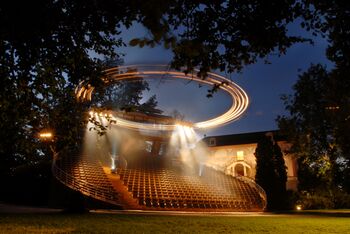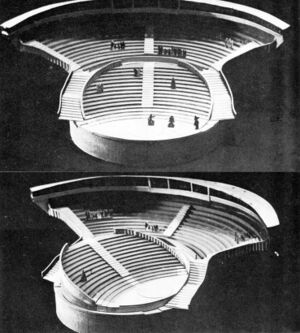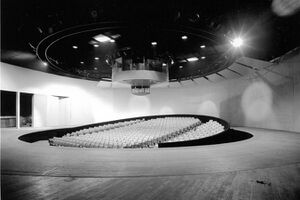A Moving Experience
Revolving stages are commonplace, but systems to rotate the audience are rare. The outdoor revolving theatre in the grounds of Český Krumlov Castle in the Czech Republic, dating from 1958, is one example.
For more than a half of century, the revolving theatre in the gardens of Český Krumlov Castle has been a significant and unusual example of an outdoor theatre with a unique design and utilisation of scenic space. This open-air amphitheatre, with a revolving auditorium designed by Joan Brehms, is set amongst trees many hundreds of years old, and has been progressively remodelled over its lifetime.
Joan Brehms (Q21388) was a theatre architect, stage designer and painter, strongly influenced by the Bauhaus. In the late 1920s and early 1930s he worked as a stage designer at the German Drama Theatre in Riga, Wrocław and Gdańsk. He participated in productions in non-theatre environments and was at the birth of new theatre spaces, the most famous of which is the revolving auditorium from 1958.
The purpose of the revolving theatre was to disrupt, to destroy deliberately and functionally the convention of a proscenium stage, to use inversely the principle and functions of the stage revolve, to create dynamics in the theatre by the movement of the auditorium, to search for a new stage design, modes and means, and specific directional procedures and means of actors’ expressions. As the audience turns, it faces different parts of the gardens, where the scenes are played out, with the various vistas and the summer palace providing the backdrops.
The origins of the Český Krumlov revolving auditorium (Q12843) are in the Jihočeský divadelní festival (South Bohemia Theatrical Festival) in the summer months. The first seasons of theatre productions in the Český Krumlov castle occurred in 1947 and 1948 and several performances took place in front of the Bellarie summerhouse, as well as the cascade fountain in the castle garden. The construction of the revolving theatre as a circular rotating auditorium was initially complicated; the first small wooden constructions were soon being replaced by larger variants.
A new auditorium with the considerably higher capacity of 400 seats was installed for the summer of 1959. Since then, the basic construction scheme has not changed over the years: a platform with rows of seats ascending over the circular base, and topped by a lighting and technical cabin. To begin with the auditorium was rotated manually, powered by 40 soldiers, but later it was driven by an electric motor.
A large reconstruction of the rotating base occurred in 1960s and 1970s. The auditorium was given a new drive system (bantam wheels), the wooden seats were replaced by laminate ones, the capacity was increased to 800 spectators, and dressing rooms were created in the Bellarie summer palace basement.
In recent years, there has been a great deal of debate about the suitability of this stage and its location immediately in front of the summer palace in the castle gardens. Opinions in favour of the theatre emphasise the unique atmosphere of performances at night, while the opposing opinion points out, among other things, the problematic aesthetic qualities of the auditorium and its unsuitable placement on the central axis of the geometric Baroque gardens.
Brehms returned several times to the idea of the folding and portable auditorium for 1200–1500 spectators over the years since the theatre at Český Krumlov. An indoor revolving theatre, which Brehms was also experimenting with in later years, was realised in 1959 by Jacques Polieri in Paris. The 1972 New London Theatre in London, UK (Q9377), has a central revolve 60ft across which accommodates the stage, orchestra pit and the first eight rows of seats, which form a theatre-in-the-round when the revolve is turned.
These theatres have earlier precedents: the Roman emperor Nero had an octagonal banquet hall which would imitate the movement of the Earth while allowing the emperor to see all the guests from his central position. This concept was taken up by Joseph Furttenbach (Q60), in his 1650 design for a play about the triumph of Christianity over the Roman Empire. Furttenbach arranged four stages around the central auditorium, each with a different scene, much as Brehms did 300 years later with the four garden views.
The idea of revolving theatre must also be understood in the context of the Totaltheater project of 1926. The main inspirational source for Brehms was unquestionably the founder of the Bauhaus, architect Walter Gropius (Q73), who developed the Totaltheater concept together with Erwin Piscator (G.07, Q72).


